SUMMARY
This is AI generated summarization, which may have errors. For context, always refer to the full article.
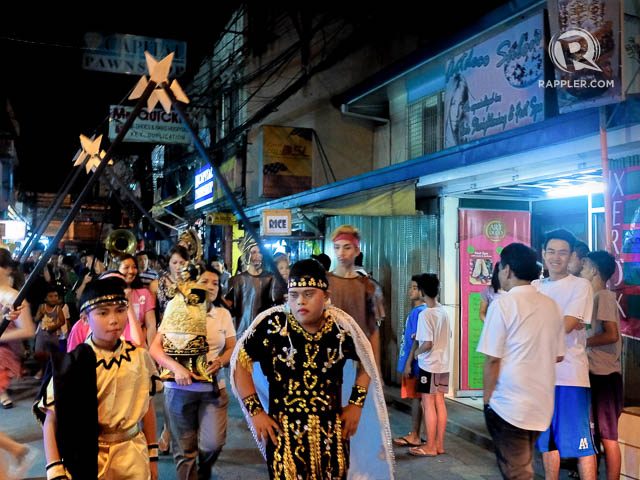
The alley appeared endless. After walking for the past 20 minutes in a concrete labyrinth, I caught my breath and asked a group of women for directions to their town plaza. “You’re still quite far” one said. Penitence came early on a hot and humid summer’s night.
I trotted on, evading the mounds of earth and feared being trampled underfoot by a jeep as it squeezed through the narrow road.
Pasay is a highly urbanized city within the south of Manila. The roots go as far back to the 12th century. It is named after a princess of the Namayan Kingdom, Dayang-dayang Pasay. I’ve called it home for the past 7 years. One could be anywhere in the world with its soulless casinos and shopping centers, but when you look hard enough, you may still find a few gems.
The township of Malibay was annexed to Pasay in 1903. Through Spanish colonization, Christianity or Catholicism became the prevalent religion in the Philippines. Each town with its own patron saint takes pride in the various religious festivals celebrated during Lent.
The Malibay cenaculo is a Passion play on the life of Christ and is one of the longest running of its kind in the Philippines. Cenaculo (or cenacle) is derived from Spanish and describes the place where Jesus Christ and his disciples celebrated the Last Supper. It began along the outskirts of Pasay in 1902 and is roughly based on Filipino poet Gaspar Aquino de Belen’s Pasyon.
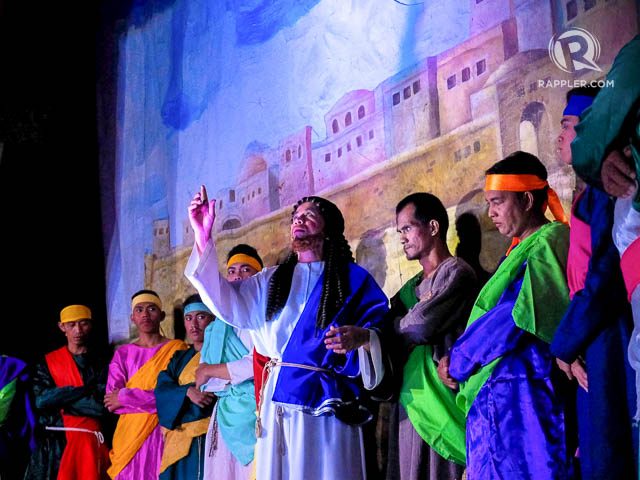
Drenched in sweat, I reached the main market. Malibay is a self-sufficient blue collar mini metropolis. From fresh produce, small restaurants, barber shops right down to tailors, they have it all. The bright lights shone across the streets which seemed to extend into the cores of the earth. More people walked behind me, one after the other like ants at work. Vibrant with local color, alive at night!
The cenaculo is traditionally performed on a proscenium-like stage and takes at least 8 days to present. The Malibay cenaculo pushes on to ten. After calling the barangay, I was baffled to hear that there were plays starting at 9 every night since Palm Sunday.
It is highly common to head out on Good Friday to view the commemoration of Christ’s crucifixion and death around the Philippines, rarely have I seen plays of the same nature at night. Despite it being celebrated for over a hundred years, sadly barely a few know of it in Manila.
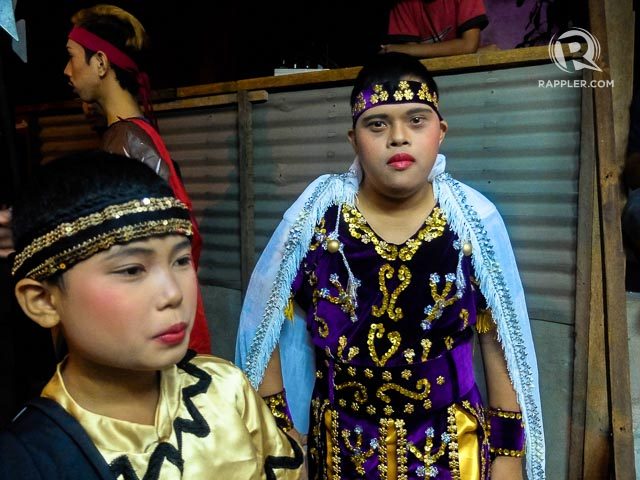
I was pointed to a large unfinished building with steel rods sticking out, dance music blaring loudly in the background. A makeshift dressing room was set up along the main street, with walls of galvanized iron sheets and an old rickety wooden door.
I knocked. The head of a middle aged man peeked through as motorcycles whizzed by. I was stunned as the light hit his face; garish make-up of pink cheeks with blue and gold eye shadow heavily painted his lids. A large gold chain lay snug around his thick neck. I was speechless. My eyes gazed down to his bare arms with a number of crude tattoos.
“I’d like to ask permission to watch and document your play,” I said, holding out my hand. He was just as surprised to see me. I wondered what I had gotten myself into. His kindness contradicted his intimidating manner and led me quickly through the crowd.
We passed people of all ages, shapes and sizes. A select few sat on plastic chairs, make-up artists in a frenzy attaching fake beards with white glue and sawdust. Festive, happy and chaotic.
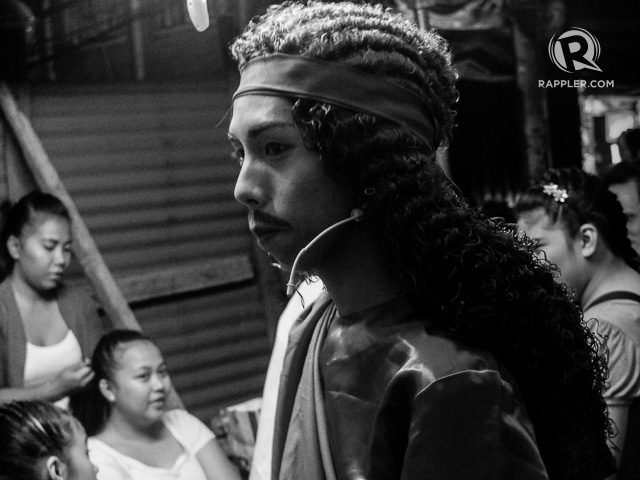
The president of the cenaculo received me. His old fashioned Tagalog was deep and I struggled to understand. “It is through the grace and guidance of the Holy Spirit that you have come to us tonight,” he said.
I felt the weight of his words on my head and prayed not to be hit by a bolt of lightning. The play had been running for over four nights and few had come from the outside to watch. He had assumed my urgency to take part and to document was somewhat miraculous!
It was quite remarkable to learn that the people and actors who make the cenaculo possible were all born in Malibay. Their dedication and solemn promise to God have withstood at least 4 generations.
A group of men dressed as Roman soldiers who looked like extras from a Hollywood Spartacus production were to fetch Malibay’s Patron Saint San Juan Nepomuceno from the local parish to bring to the stage. The image is returned to the church after each performance. It felt surreal to walk with them through the busy streets and market.
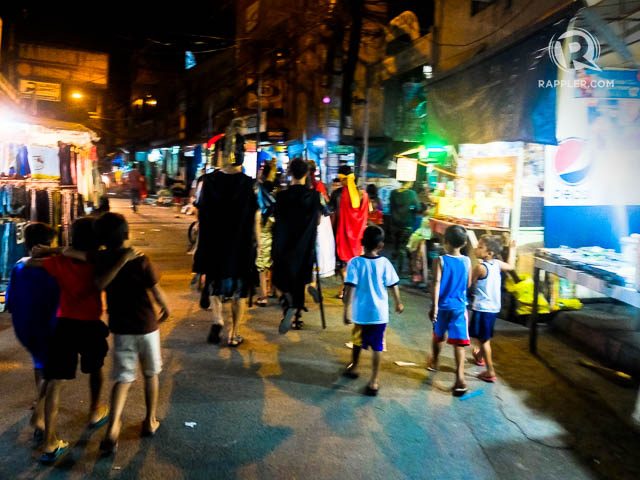
The local marching band whose roots hail back to the 1960s with a full wind section, provided the music for the entire event. The band played the theme to the movie Ice Castles, (oh the irony, as we sweltered in the heat!) “Don’t let this feeling end…looking through the eyes of love…” Nice touch. The curtains were drawn; Jesus came out with his Apostles, two stepping and marching to a funereal sounding rhythm. The chants transfixed the crowd.
I made my way to interview the various characters of the play from Judas to Mary, the Apostles to those who were cast with smaller parts. Their sentiment was universal with a strong sense of tradition. The community of Malibay could teach the rest of Manila a thing or two. The question, can it continue in such modern times?
“I’ve played Jesus for almost 20 years, it is my vow,” one now retired nurse said. For a short time every single year, people revere him for the role he plays. The other months, in reality, pass by. Life is difficult, with no way around it. And he remains ordinary just like everybody else.
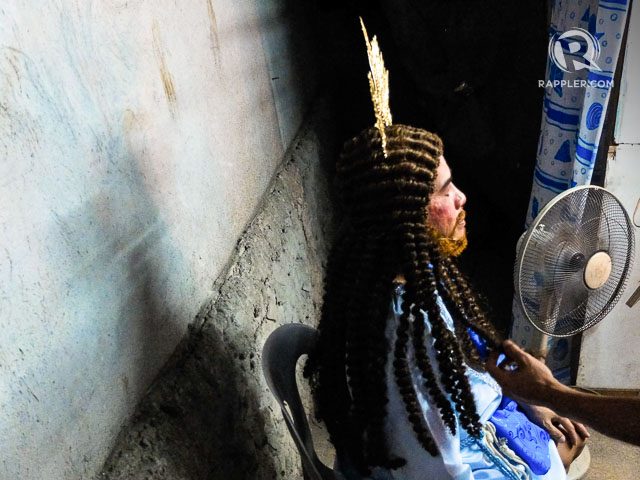
The actor lets me sit next to him, a fan close to his face to help dry his beard. His heavy wig barely moving with the wind.
“I couldn’t walk two months prior, after my spine gave way, leaving me half paralyzed.”
He let me check his back from under the robe. I felt an industrial girdle strapped around him.
“How do you feel?” I asked.
“Great!,” he said. “With faith, nothing is impossible.”
He stood up to walk to the stage to resume his role, his heart in the right place. – Rappler.com
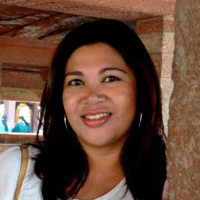
Shirin Bhandari is an artist, writer and jewelry designer. She graduated from the University of the Philippines with a degree in Fine Arts. She established her accessory and handicraft store Sundari in 2005, and supplies her designs to Rajo Laurel and the Ayala Museum. She’s lived in India and Manila and enjoys travel and dabbles in photography during her free time. Follow her onFacebook and on Instagram
Add a comment
How does this make you feel?
There are no comments yet. Add your comment to start the conversation.